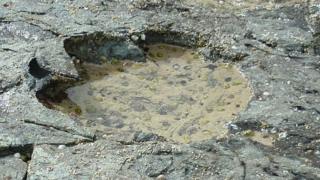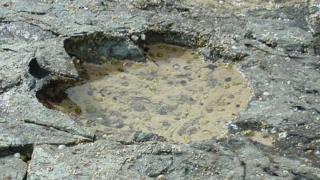Bid to better protect Scotland’s ‘Dinosaur Isle’

 Image copyright Jon Hoad
Image copyright Jon Hoad Dinosaur and other animal fossil sites in Skye have been given new legal protection in a bid to deter unscrupulous collectors.
The isle is internationally recognised for its fossils of creatures that lived more than 165 million years ago.
But some of the prehistoric locations have been badly damaged by collectors removing valuable specimens.
The Scottish government has issued a Nature Conservation Order (NCO) for Skye’s sites.
It is an offence to breach an NCO.
Fossils can only be removed for scientific purposes or to preserve them, with consent of Scottish Natural Heritage (SNH).
Residents of Skye have been encouraged to report suspicious activity at the sites as part of the new effort.
Dubbed Scotland’s “Dinosaur Isle”, Skye is rich in fossils from the Middle Jurassic.
Finds include the earliest turtles known to have lived in water. The reptile fossils were found on a beach on the Strathaird peninsula.
Studies of dinosaur footprints at Valtos have been used by palaeontologists to explain Australia’s “Dino stampede”, a large number of prints believed to have been made by small dinosaurs possibly fleeing from a predator..
Evidence of a small Jurassic mammal has also been found in the island. The jaw of the shrew-like Borealestes serendipitus was discovered more than 40 years ago, the first time such a find had been made of the animal.
Recent discoveries include what could be the remains of flying reptiles, or pterosaurs.
A number of important fossils are held in the care of the island’s Staffin Museum, but many have already been lost or damaged.
In 2011, tonnes of rock were dug away from cliffs near Bearreraig Bay, north of Portree, in an apparent organised search for valuable specimens.
Dinosaur footprints were also removed from Valtos.
In 2016, an attempt to take a plaster cast of a dinosaur footprint at An Corran risked significant damage to the fossil.
Natural Environment Minister Mairi Gougeon has authorised the new protection order.
She said: “Skye lays claim to the most significant dinosaur discoveries of Scotland’s Jurassic past and this Nature Conservation Order is a vital step in protecting and preserving this important part of our natural heritage for future generations.
“The order gives extra legal protection to these special sites whilst providing for important artefacts to be collected responsibly for science and public exhibition.”
Geologist Colin MacFadyen, of SNH, said the NCO covered an area of coastline with 165 million year old rocks.
He said: “It is crucial that the footprints and actual skeletal remains of dinosaurs and other vertebrates that are being revealed by nature are protected.
“These fabulous fossil finds can help answer crucial questions about ancient ecosystems and pave the way for exciting advances in our understanding of vertebrate evolution.”


